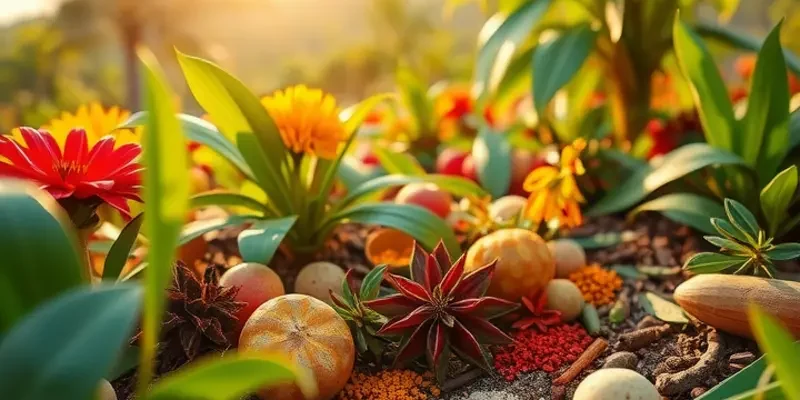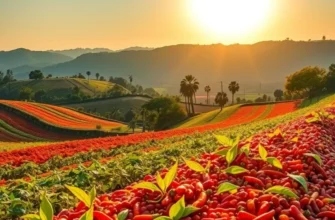The tropics, with their lush landscapes and diverse cultures, are a feast for the senses. This vibrant region boasts a rich tapestry of culinary traditions shaped by geography, history, and the fusion of native and colonial influences. From the spice-laden dishes of the Caribbean to the refreshing tropical fruits of Southeast Asia, the food of the tropics tells a story of passion, creativity, and sustainability that inspires food lovers worldwide.
Caribbean Spice: The Flavorful Melting Pot

Dive into the vibrant world of Caribbean cuisine, where the harmony of spices ignites the senses. This region, a tapestry of histories and cultures, showcases its identity through an impressive array of bold flavors, drawing culinary influences from Africa, Europe, the Americas, and Asia.
A cornerstone of Caribbean cuisine is the use of spices. Allspice, revered for its warm, peppery notes, is indispensable in many dishes. This unique spice brings a rich depth to marinades, defining the flavor profile of jerk seasoning. The legendary jerk chicken, a symbol of Jamaica, is the perfect introduction to the island’s dynamic spice culture.
The thrilling heat of scotch bonnet peppers cannot be underestimated. These bright gems add fiery warmth to dishes like pepperpot, a slow-cooked stew with roots tracing back to the indigenous people of the Caribbean. Despite its heat, the fruity undertones of scotch bonnet complement the sweetness in many tropical ingredients.
Seafood plays a critical role in the Caribbean diet, reflecting the region’s maritime legacy. From the succulent grilled fish of Trinidad to Barbados’ flying fish, seafood dishes are vibrant. The freshness of the sea is often enhanced with lime, a tropical citrus that brightens any dish.
Caribbean chefs excel in the art of balance. They fuse the sweetness of ripe plantains with savory meats, achieving a delightful contrast. Plantains, enjoyed fried or boiled, are integral to meals, celebrating the starchy fruit’s versatility.
Roti, a staple with Indian origins, showcases the influence of indentured laborers from India. Caribbean roti is a soft, flaky flatbread, typically used to wrap curried meats and vegetables. Each bite unveils a story of cultural convergence on the islands.
Preparation techniques in the Caribbean are equally intriguing. The slow smoking of meats not only infuses food with flavor but is a cultural practice, passed through generations. This method preserves the bold taste of spices and tenderizes tougher cuts of meat.
Exploring Caribbean dishes highlights a commitment to using local produce. A celebration of fresh, seasonal ingredients is evident in every meal. For those keen on integrating these flavors at home, using flavorings like scotch bonnet or experimenting with spice blends can be a gastronomic adventure. You can find tips for using flavor boosters beyond salt here.
Ultimately, each dish tells a story of the Caribbean’s diverse community, merging vibrant ingredients with global techniques to create a unique culinary identity. The region’s flavors are a testament to its history and to the imaginative prowess of its people.
Southeast Asian Sensations: A Bold Culinary Landscape

In the heart of Southeast Asia lies a culinary landscape that pulsates with vibrancy and intrigue. This region’s cuisine captivates with its sensuous dance of flavors and textures, achieved through the clever use of native ingredients. Central to many dishes are the aromatic lemongrass, creamy coconut milk, and a medley of fresh herbs. Each element contributes its distinct character, enhancing the harmony of flavors that Southeast Asian food is renowned for.
Consider Thai curry, where the mellow sweetness of coconut milk finds its perfect partner in the bright citrusy zing of lemongrass. This combination is then heightened by the addition of chili, galangal, and kaffir lime leaves, weaving a tapestry of taste that’s both comforting and exciting. The balance of sweet, sour, salty, and spicy elements is not a mere culinary technique here—it’s an art form.
Equally fascinating is the Vietnamese pho, a dish that exemplifies the finesse of flavor layering. The broth, typically simmered for hours, is infused with spices such as star anise and cinnamon, yielding a rich, aromatic foundation. This depth is offset by the freshness of herbs like cilantro and Thai basil, and a squeeze of lime, which delivers a sharp note that elevates the entire experience. Few dishes epitomize umami—the so-called fifth taste—as delicately and effectively as pho.
Dive into Indonesian nasi goreng, and you’ll encounter the symphony of flavors balanced over a core of rice. Dark, sweet soy sauce mingles with tamarind, offering a juxtaposition of sweet and sour. Shrimp paste introduces a savory depth while a touch of chili provides a gentle heat, making this fried rice dish a comfort food staple. Nasi goreng showcases the region’s skill in layering flavors to create depth without overwhelming the palate.
Southeast Asian dining is as much about the ritual as the flavors themselves. Communal dining is common, with dishes placed in the center of the table to be shared by all. This creates a sense of togetherness, fostering conversations and connections over shared meals. Such traditions underscore the cultural importance of food as a communal experience, not just a solitary pleasure.
For those seeking flavor boosters without salt, Southeast Asian cuisines provide excellent models through their reliance on herbs, spices, and natural sweeteners to create impactful tastes. These practices highlight an intrinsic understanding of balance in cooking, one that doesn’t rely on salt as its sole enhancer.
In this journey through Southeast Asia’s culinary landscape, the use of unique ingredients and innovative techniques forms an irresistible emblem of the region’s cultural richness. From curries to soups, and beyond, the flavors invite us to explore their depths and discover the beauty of culinary tradition crafted over generations.
Final words
The culinary traditions of the tropics are as diverse and rich as the landscapes that produce them. They reflect centuries of history, cultural fusion, and the natural bounty of each region. Through embracing spices, fresh herbs, and traditional cooking methods, tropical cuisines present a vibrant tableau of flavors waiting to be explored. For food enthusiasts, there’s no better journey than the one through the kitchens of the tropics, where every dish narrates a unique story of the land and its people. Let these enticing flavors inspire your next culinary adventure, whether in your home kitchen or as a traveler seeking global tastes.








